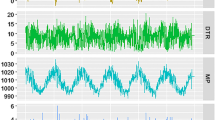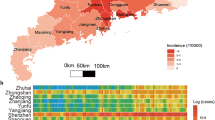Abstract
The clear seasonality of varicella infections in temperate regions suggests the influence of meteorologic conditions. However, there are very few data on this association. The aim of this study was to determine the seasonal pattern of varicella infections on the Mediterranean island of Mallorca (Spain), and its association with meteorologic conditions and schooling. Data on the number of cases of varicella were obtained from the Network of Epidemiologic Surveillance, which is composed of primary care physicians who notify varicella cases on a compulsory basis. From 1995 to 2012, varicella cases were correlated to temperature, humidity, rainfall, water vapor pressure, atmospheric pressure, wind speed, and solar radiation using regression and time-series models. The influence of schooling was also analyzed. A total of 68,379 cases of varicella were notified during the study period. Cases occurred all year round, with a peak incidence in June. Varicella cases increased with the decrease in water vapor pressure and/or the increase of solar radiation, 3 and 4 weeks prior to reporting, respectively. An inverse association was also observed between varicella cases and school holidays. Using these variables, the best fitting autoregressive moving average with exogenous variables (ARMAX) model could predict 95 % of varicella cases. In conclusion, varicella in our region had a clear seasonality, which was mainly determined by solar radiation and water vapor pressure.






Similar content being viewed by others
References
Vázquez M (2004) Varicella zoster virus infections in children after the introduction of live attenuated varicella vaccine. Curr Opin Pediatr 16:80–84
Brisson M, Edmunds WJ, Law B, Gay NJ, Walld R, Brownell M, Roos L, De Serres G (2001) Epidemiology of varicella zoster virus infection in Canada and the United Kingdom. Epidemiol Infect 127:305–314
Russell ML, Svenson LW, Yiannakoulias N, Schopflocher DP, Virani SN, Grimsrud K (2005) The changing epidemiology of chickenpox in Alberta. Vaccine 23:5398–5403
Kokaze A, Yoshida M, Sekine Y, Ishikawa M, Kurokochi T, Uchida Y, Matsunaga N, Takashima Y (2001) The magnitude of variation in temperature within a year has an effect on the seasonal variations of chickenpox incidence in Japan. Epidemiol Infect 126:269–277
Sinha DP (1976) Chickenpox—a disease predominantly affecting adults in rural West Bengal, India. Int J Epidemiol 5:367–374
Mandal BK, Mukherjee PP, Murphy C, Mukherjee R, Naik T (1998) Adult susceptibility to varicella in the tropics is a rural phenomenon due to the lack of previous exposure. J Infect Dis 178(Suppl 1):S52–S54
Lolekha S, Tanthiphabha W, Sornchai P, Kosuwan P, Sutra S, Warachit B, Chup-Upprakarn S, Hutagalung Y, Weil J, Bock HL (2001) Effect of climatic factors and population density on varicella zoster virus epidemiology within a tropical country. Am J Trop Med Hyg 64:131–136
Garnett GP, Cox MJ, Bundy DA, Didier JM, St Catharine J (1993) The age of infection with varicella-zoster virus in St Lucia, West Indies. Epidemiol Infect 110:361–372
Lee BW (1998) Review of varicella zoster seroepidemiology in India and Southeast Asia. Trop Med Int Health 3:886–890
Rice PS (2011) Ultra-violet radiation is responsible for the differences in global epidemiology of chickenpox and the evolution of varicella-zoster virus as man migrated out of Africa. Virol J 8:189. doi:10.1186/1743-422X-8-189
Vaughan G, Rodríguez-Castillo A, Cruz-Rivera MY, Ruiz-Tovar K, Ramírez-González JE, Rivera-Osorio P, Fonseca-Coronado S, Carpio-Pedroza JC, Cazares F, Vazquez-Pichardo M, Anaya L, Escobar-Gutiérrez A (2011) Is ultra-violet radiation the main force shaping molecular evolution of varicella-zoster virus? Virol J 8:370. doi:10.1186/1743-422X-8-370
Critselis E, Nastos PT, Theodoridou K, Theodoridou M, Tsolia MN, Hadjichristodoulou C, Papaevangelou V (2012) Time trends in pediatric hospitalizations for varicella infection are associated with climatic changes: a 22-year retrospective study in a tertiary Greek referral center. PLoS One 7(12):e52016. doi:10.1371/journal.pone.0052016, Epub 2012 Dec 28
Diggle PJ (1990) Time series: a biostatistical introduction. Oxford statistical science series, 5. Clarendon Press, Oxford
Tang JW (2009) The effect of environmental parameters on the survival of airborne infectious agents. J R Soc Interface 6(Suppl 6):S737–S746. doi:10.1098/rsif.2009.0227.focus, Epub 2009 Sep 22
Pérez-Farinós N, Ordobás M, García-Fernández C, García-Comas L, Cañellas S, Rodero I, Gutiérrez-Rodríguez A, García-Gutiérrez J, Ramírez R (2007) Varicella and herpes zoster in Madrid, based on the Sentinel General Practitioner Network: 1997–2004. BMC Infect Dis 7:59. doi:10.1186/1471-2334-7-59. Available online at: http://www.biomedcentral.com/1471-2334/7/59
Nardone A, de Ory F, Carton M, Cohen D, van Damme P, Davidkin I, Rota MC, de Melker H, Mossong J, Slacikova M, Tischer A, Andrews N, Berbers G, Gabutti G, Gay N, Jones L, Jokinen S, Kafatos G, de Aragón MV, Schneider F, Smetana Z, Vargova B, Vranckx R, Miller E (2007) The comparative sero-epidemiology of varicella zoster virus in 11 countries in the European region. Vaccine 25:7866–7872
Zak-Prelich M, Borkowski JL, Alexander F, Norval M (2002) The role of solar ultraviolet irradiation in zoster. Epidemiol Infect 129:593–597
Yusuf S, Piedimonte G, Auais A, Demmler G, Krishnan S, Van Caeseele P, Singleton R, Broor S, Parveen S, Avendano L, Parra J, Chavez-Bueno S, Murguía De Sierra T, Simoes EA, Shaha S, Welliver R (2007) The relationship of meteorological conditions to the epidemic activity of respiratory syncytial virus. Epidemiol Infect 135:1077–1090
du Prel JB, Puppe W, Gröndahl B, Knuf M, Weigl JA, Schaaff F, Schmitt HJ (2009) Are meteorological parameters associated with acute respiratory tract infections? Clin Infect Dis 49:861–868
Lowen AC, Mubareka S, Steel J, Palese P (2007) Influenza virus transmission is dependent on relative humidity and temperature. PLoS Pathog 3:1470–1476
Leclair JM, Zaia JA, Levin MJ, Congdon RG, Goldmann DA (1980) Airborne transmission of chickenpox in a hospital. N Engl J Med 302:450–453
Sawyer MH, Chamberlin CJ, Wu YN, Aintablian N, Wallace MR (1994) Detection of Varicella-zoster virus DNA in air samples from hospital rooms. J Infect Dis 169:91–94
Morawska L (2006) Droplet fate in indoor environments, or can we prevent the spread of infection? Indoor Air 16:335–347
Fiegel J, Clarke R, Edwards DA (2006) Airborne infectious disease and the suppression of pulmonary bioaerosols. Drug Discov Today 11:51–57
Shaman J, Pitzer VE, Viboud C, Grenfell BT, Lipsitch M (2010) Absolute humidity and the seasonal onset of influenza in the continental United States. PLoS Biol 8:e1000316
Norval M (2006) The effect of ultraviolet radiation on human viral infections. Photochem Photobiol 82:1495–1504
Gallerani M, Manfredini R (2000) Seasonal variation in herpes zoster infection. Br J Dermatol 142:588–589
Xu H, Elmets CA (2012) UVB immunosuppression: vitamin D or not vitamin D? That is the question. J Invest Dermatol 132:2676–2678
Schwarz A, Navid F, Sparwasser T, Clausen BE, Schwarz T (2012) 1,25-dihydroxyvitamin D exerts similar immunosuppressive effects as UVR but is dispensable for local UVR-induced immunosuppression. J Invest Dermatol 132:2762–2769
Leung KH (1989) Inhibition of human natural killer cell and lymphokine-activated killer cell cytotoxicity and differentiation by vitamin D3. Scand J Immunol 30:199–208
Orange JS (2013) Natural killer cell deficiency. J Allergy Clin Immunol 132:515–525
Jackson C, Mangtani P, Fine P, Vynnycky E (2014) The effects of school holidays on transmission of varicella zoster virus, England and Wales, 1967–2008. PLoS One 9(6):e99762. doi:10.1371/journal.pone.0099762, eCollection 2014
Centers for Disease Control and Prevention (CDC) (1999) Evaluation of varicella reporting to the National Notifiable Disease Surveillance System—United States, 1972–1997. MMWR Morb Mortal Wkly Rep 48:55–58
Funding
The authors have no funding to declare.
Conflict of interest
The authors have no conflicts of interest to disclose.
Author information
Authors and Affiliations
Corresponding author
Rights and permissions
About this article
Cite this article
Hervás, D., Hervás-Masip, J., Nicolau, A. et al. Solar radiation and water vapor pressure to forecast chickenpox epidemics. Eur J Clin Microbiol Infect Dis 34, 439–446 (2015). https://doi.org/10.1007/s10096-014-2243-3
Received:
Accepted:
Published:
Issue Date:
DOI: https://doi.org/10.1007/s10096-014-2243-3




